What to Do if You Run Out of Easy Cbm Probes
Schools can teach academic skills 24/7/365. However, failing to measure the extent to which students are acquiring these skills can be detrimental to their educational upbringing. That's why methods such as curriculum-based measurement, or CBM, are vital for student success.
And as a school leader, you play a critical role in fostering the right culture for student success. But how?
The early history of CBM
In the mid-1970s, late American educational psychologist and director of the Special Education Program at the University of Minnesota, Stanley Lynn "Stan" Deno, began his research on what would become known as curriculum-based measurement.
Teachers at that time didn't have many fair or accurate methods to formatively assess students. In the journal ISRN Education, Gerald Tindal writes:
Basal series had mastery tests with little technical adequacy (reliability and validity) in decision making and actually misinformed teachers about skills being learned and practiced by students. Informal reading inventories and readability-based estimates of passage difficulty were not (and are still not) reliable.
Hence Deno's interest in — and need for — a new and improved method of measurement.
His initial decade's worth of work focused primarily on the three areas of language arts (i.e., reading, writing, and spelling).
Long-term, Deno's data-based program modification manual helped establish measurement systems that:
- Were easy to construct
- Were quick to administer and score
- Usable by all
- Had technical adequacy
- Allowed time series data to be collected on student programs
Eventually, curriculum-based measurement expanded to include mathematics and secondary subjects. However, researchers acknowledge they need to conduct further technical research in these areas.
Ultimately, CBM should influence teachers' decision-making and practices in a way that improves individual student progress and performance.
What is curriculum-based measurement?
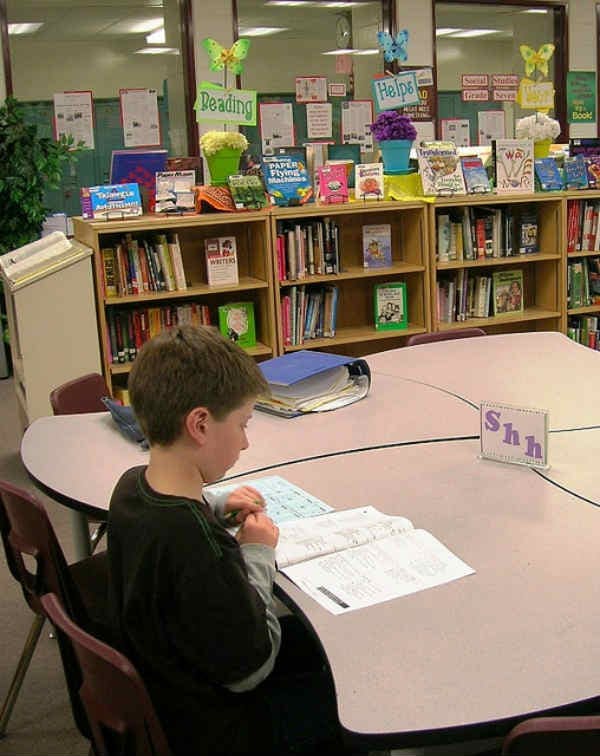
Credit: Enokson
Remember having to write tests every two or three weeks at the end of a math, science, social studies, reading, insert-school-subject-here unit?
At the end of the term or year, you'd get a report card listing all your averaged scores.
A summative assessment is fantastic for emphasizing the product of student learning. But it falls short in regard knowing the process of student learning.
Enter CBM.
In short, curriculum-based measurement is a powerful assessment tool teachers can use to both test and measure student progress.
Jim Wright, a certified school psychologist and school administrator in central New York State, created Curriculum-Based Measurement: A Manual for Teachers. And in it, he defines CBM as:
A method of monitoring student educational progress through direct assessment of academic skills. CBM can be used to measure basic skills in reading, mathematics, spelling, and written expression. It can also be used to monitor readiness skills.
What's more, curriculum-based measurement is an excellent way for teachers to gauge the effectiveness of their own instructional methods.
How does CBM work?
Teachers who implement CBM will briefly test students, usually once or twice a week, based on academic content from their school curriculum.
These tests, or "probes," are intended to be brief and last anywhere from one to five minutes, depending on the skills they want to measure.
In mathematics, for example, you can give students eight questions and five minutes to complete them all. Or, in reading, you can give them a one-minute reading test.
Upon completing the CBM test, you'd record the number of correct and incorrect answers or words on a graph.
Plotting these points against the expected performance in various subject areas helps school administrators, teachers, and parents visualize students' academic progress.
Though formative in nature, Wright clarifies:
These CBM probes are given under standardized conditions. For example, the instructor will read the same directions every time that he or she gives a certain type of CBM probe…The child's performance on a CBM probe is scored for speed, or fluency, and for accuracy of performance.
Disadvantages of traditional testing methods
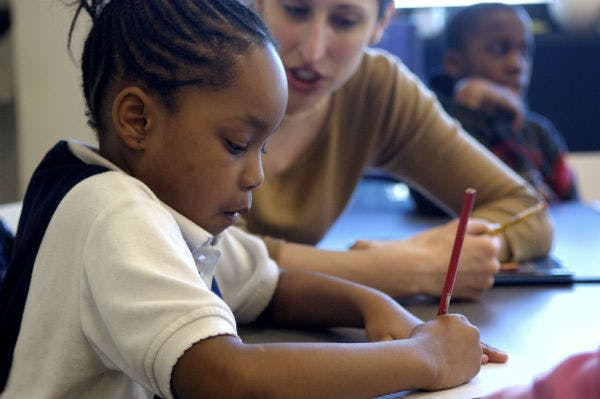
Credit: US Department of Education [Public domain], via Wikimedia Commons
At the right time and in the right place, traditional academic or "norm-referenced" tests serve a legitimate purpose.
When creating these tests, developers rely on statistical methods in order to choose the norming group, interpret scores, and determine benchmarks.
According to The Glossary of Education Reform, "norm-referenced tests report whether test takers performed better or worse than a hypothetical average student."
Interestingly, however, "norming groups typically comprise only a small subset of previous test takers, not all or even more previous test takers."
What traditional academic tests can't effectively do is:
1. Gauge student growth
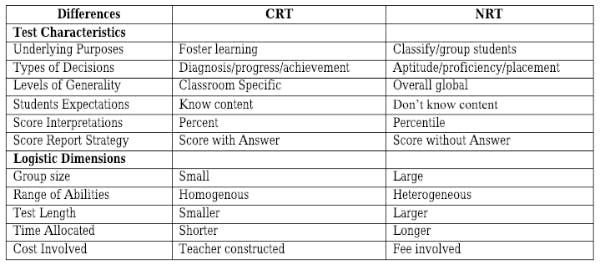
Credit: Difference in Norm-Referenced and Criterion-Referenced Tests adapted from Brown (1992)
Norm-referenced tests already occur infrequently. What's worse, depending on them to monitor student progress can result in missing opportunities to fill small yet significant learning gaps.
2. Keep up with student progress
These types of tests happen too infrequently to address and adapt to students' academic needs.
Even when completing a norm-referenced test twice per year, there's such a large gap between assessments that knowing whether or not certain teaching strategies worked becomes very challenging.
3. Match local or classroom curriculum
The questions and content areas included in a norm-referenced test won't always align with the skills a student has learned leading up to it.
Results could mislead you to think students are underperforming when, in reality, they were unfamiliar with the test content.
4. Highlight a specific class' skill levels
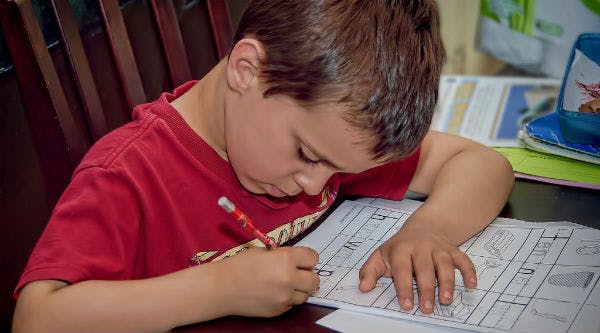
Credit: Chris Yarzab
Performance standards of norm-referenced tests are set according to a national average. This approach is to ensure all schools can use them, understandably.
However, teachers are well aware that class averages can vary drastically from national ones. Therefore, traditional tests can't necessarily pinpoint a group of students' true learning gaps.
Reading this might lead you to wonder how much more effective curriculum-based measurement is than other testing methods.
Advantages of curriculum-based measurement
Using CBM in the classroom comes with number of great advantages. What curriculum-based measurement can do is:
1. Take minimal time to administer

Credit: Ilmicrofono Oggiono
Whether measuring math, reading, or writing fluency, CMBs take hardly any time. For example, in under five minutes, teachers can assign group math or individual reading probes.
2. Effectively gauge short-term student growth
CBM probes quickly provide teachers with their class' average academic performance.
In contrast to norm-referenced tests, curriculum-based measurements enable teachers to identify students who are struggling to acquire and apply specific academic skills.
3. Be given regularly
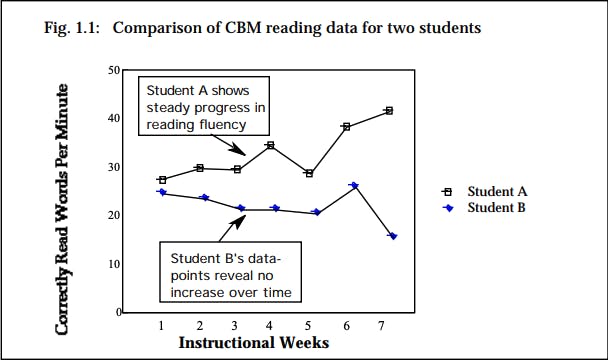
Source: Jim Wright's "Curriculum-Based Measurement: A Manual for Teachers"
The more data the better, which is why CBM probes are so effective. For instance, teachers who want to gauge their students' math fluency in a short time span can run daily three-minute tests for two weeks.
With two weeks of math fluency results plotted on individual graphs, teachers can visualize student progress and identify learning gaps.
Prodigy, for example, uses adaptive learning technology which adjusts content to accommodate different learning styles and tackle trouble spots. On top of that, it provides Progress, Student Comprehension, Student Usage reports, and more.
And the sooner these are identified, the higher the chances are of student progress.
4. Inform a teacher's instruction
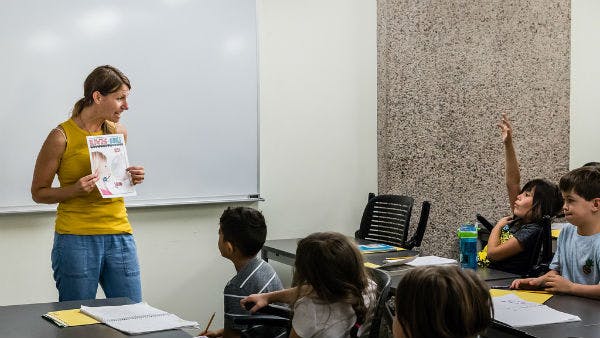
Credit: ASU Department of English
Because CBM enables such close monitoring of student progress, or lack thereof, teachers can also improve or adjust their instruction.
If students are failing to acquire foundational academic skills crucial to future success, a teacher might:
- Increase instructional time
- Implement different teaching strategies
- Switch up grouping arrangements (e.g., individual vs small-group instruction)
With continued CBM probes, teachers will be able to see whether their instructional adjustments are making a significant difference.
What's more, Wright highlights the fact that research shows:
Teachers who use CBM to monitor the effectiveness of instructional interventions tend to achieve significantly higher rates of student learning than those instructors who rely on more traditional test measures.
5. Motivate students to improve
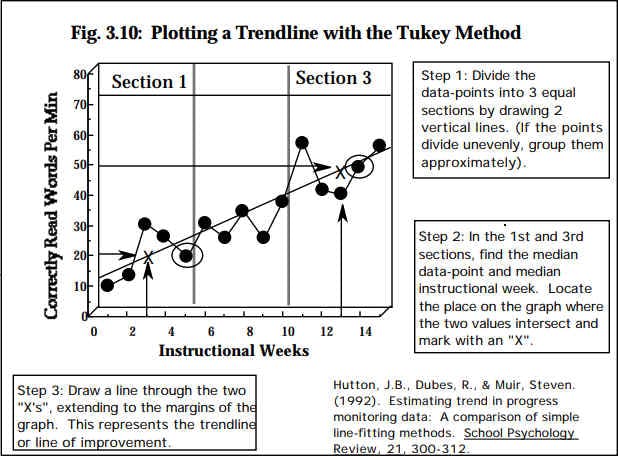
Source: Jim Wright's "Curriculum-Based Measurement: A Manual for Teachers"
Praising students for their achievements is highly encouraged. But there's something about seeing progress -- seeing the upward tick -- that excites children.
Showing students their progress graphs week over week emphasizes ownership, and can help motivate them to strive for higher grades or set more ambitious academic goals.
Note: There'll be students whose graphs won't show an "upward tick." So, it may be helpful to show students their graphs individually as opposed to posting ongoing results on a dedicated wall.
6. Guarantee curriculum overlap
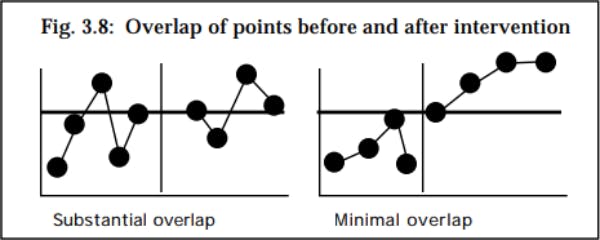
Source: Jim Wright's "Curriculum-Based Measurement: A Manual for Teachers"
With CBM, teachers create probes with materials they pull directly from curriculum. This guarantees that students will answer questions they've already encountered in the classroom.
What's more, curriculum overlap gives teachers a clearer idea of where students are succeeding or struggling based on what's actually -- not hypothetically -- being taught.
Note: There are times when norm-referenced tests align with what students have learned. More often than not, however, classrooms across the nation are in different places and learning at different paces.
7. Be a trustworthy alternative testing method
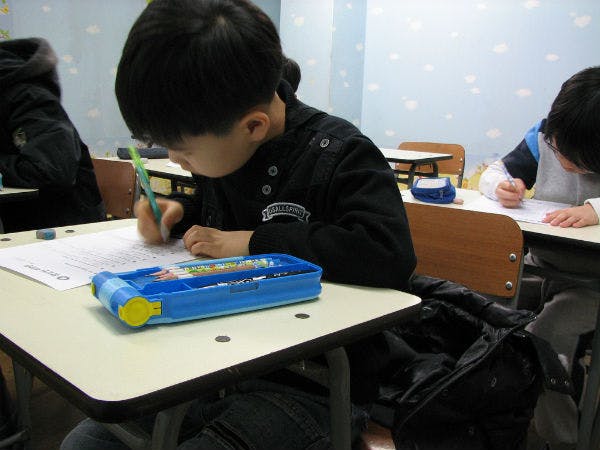
Credit: Marie
For over 30 years, educators have extensively researched curriculum-based measurement in special and general education. Tindal writes, in his brief history of CBM:
It has become a term used widely in the special education literature and has become the backbone of response-to-intervention (RTI), serving as the preferred form of progress monitoring used to evaluate instructional programs.Indeed, its staying power has been a function of (testimony to) its compatibility with traditional measurement development and the applications of standards for educational and psychological testing.Indeed, one of the core focuses on CBM was the need for technical adequacy, something which was not embedded into the fiber of the other systems.
8. Help strengthen parent involvement
Parent involvement, as Ed Can outlines, comes in different shapes and forms:
- Behaviorally involved -- parents who volunteer at school or attend school functions
- Cognitively involved -- parents who expose their children to stimulating activities, e.g., reading or visiting cultural institutions
- Personally involved -- parents who positively communicate about school with their children
A 2013 meta-synthesis published in the journal Educational Reviewexplored the impact of parental involvement on student academic achievement.
After studying the results of nine meta-analyses, professor of curricular and instructional studies at University of Akron, Dr. Sandra Wilder found:
The relationship between parental involvement and academic achievement was positive, regardless of a definition of parental involvement or measure of achievement.Furthermore, the findings reveals that this relationship was strongest if parental involvement was defined as parental expectations for academic achievement of their children…Finally, the relationship between parental involvement and academic achievement was found to be consistent across different grade levels and ethnic groups.

Credit: Pete
Teachers using curriculum-based measurement can share these detailed results with parents, too!
What better way to further engage parents than to provide weekly, let alone daily, insights into their child's progress?
Kathleen McLane worked for 21 years at the Council for Exceptional Children and joined the American Association on Intellectual and Developmental Disabilities in January 2014.
In an article for the National Center on Student Progress Monitoring, McLane writes to parents:
Examples of CBM probes
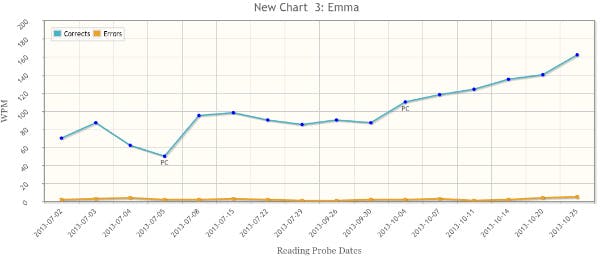
Source: Track RTI
Typically, teachers give students CBM probes to assess their reading, spelling, writing, and math skills.
Below, adapted from Wright's CBM Workshop Manual, are examples of what curriculum-based measurement can look like in each subject area.
Reading
When measuring reading fluency, it's best to do this on an individual basis.
A teacher will sit down with one student who'll read two or three selected passages aloud for one minute each. The teacher will record any errors that occurred while reading the passages.
Next, they'll take an average of the correctly read words from each passage -- this will be considered the student's true reading rate.
Spelling
When assessing spelling, teachers may read aloud 10 to 15 words in two minutes, which their students must try to spell with little to no errors.
They'll score students based on the correct letter-sequences -- i.e., properly placed pairs of letters in a word.
Take the word "spot" as an example which, as you'll see, has five correct letter-sequences:
Note: Teachers will assume the underscores before and after the word to be space-holders.
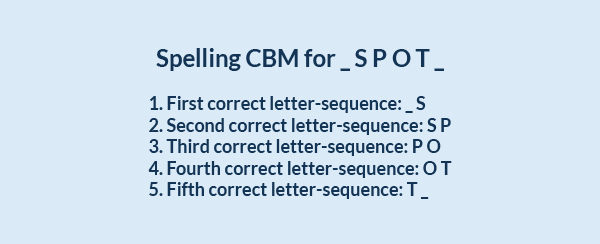
In this case, teachers would score "spot" out of five -- one mark per correct letter-sequence.
Writing
Using a story-starter, teachers will give students one minute to think of a storyline and three minutes to write as much of it as possible.
A story-starter can look something like: One day, I was at a carnival with my friend. All of a sudden, 100 balloons started floating away…
Teachers can score writing CBM probes in a number of ways. For example, they can emphasize the number of words written, the number of words spelled correctly, or a combination of the two.
Mathematics
There are two types of math probes:
- Single-skill, e.g., focusing only on multiplication
- Multiple-skill, e.g., focusing on both multiplication and division
Regardless of the math probe, students must solve as many problems as possible within, for example, three minutes.
In curriculum-based measurement, teachers score students based on the number of correct digits.
Using the example below, where incorrect digits are larger than the rest, traditional testing methods would give this a grade of 3 out of 6, or 50%.

However, when eachindividual digit is scored, it becomes clear that the student actually correctly computed 7 of 10 possible digits (70 percent). Thus, the CBM procedure of assigning credit to each correct digit demonstrates itself to be quite sensitive to a student's emerging, partial competencies in math computation.
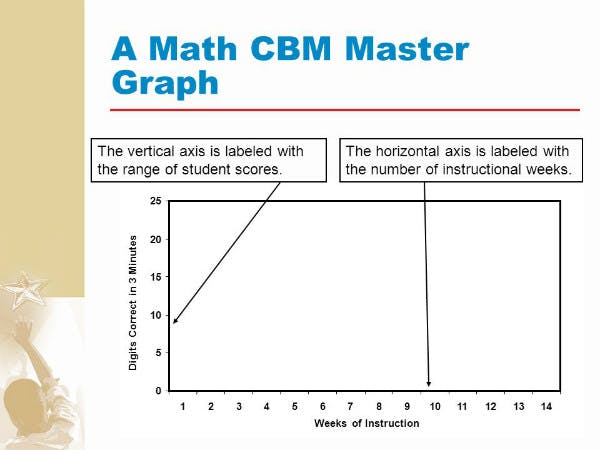
Credit: Reynold Bennett
Curriculum-based measurement tools
So, you're interested in curriculum-based measurement but aren't sure where to start. Here are a couple of excellent resources:
Prodigy Game
A digital alternative or supplement to drills worksheets, Prodigy is a curriculum-aligned math platform used by more than 100 million teachers, students and parents around the world. It offers content from every major math topic from 1st to 8th grade.
Use Prodigy to help give your school a new, easy, and engaging way to address class-wide trouble spots and academic skill deficits!
With regard to curriculum-based measurement, one of its most powerful features is using it as an RTI tool.
All while collecting data, you can deliver specific content to certain students and check their progress on a cyclical basis through:
- Plans as a first-tier RTI strategy
- Assignments as second-tier RTI strategy
CBM Warehouse
A service of Intervention Central, CBM Warehouse contains links to other websites and printable resources, such as:
- Manuals and training handouts
- CBM probes
- Directions for administration and scoring
- Selected interventions to promote academic fluency
- And more
Wrapping up: CBM's increasing importance
Research continues to show that curriculum-based measurement can greatly impact the progress and academic success of students in your school.
On top of that, CBM increases teachers' awareness and improves their teaching abilities.
Remember: implementing curriculum-based measurement in your school starts with you. Speak with your teachers about the positive impact it can have on both their students and teaching.
Place an emphasis on using CBM to measure student progress and watch their academic skills skyrocket.
Teachers? Try Prodigy Math— an adaptive, game-based learning platform that can help you turn math class into an exciting adventure.
Teachers can use Prodigy to:
- Motivate students to love learning math
- Deliver differentiated content to each student in just a few clicks
- Track student progress and make important teaching decisions
Source: https://www.prodigygame.com/main-en/blog/curriculum-based-measurement/
0 Response to "What to Do if You Run Out of Easy Cbm Probes"
Post a Comment